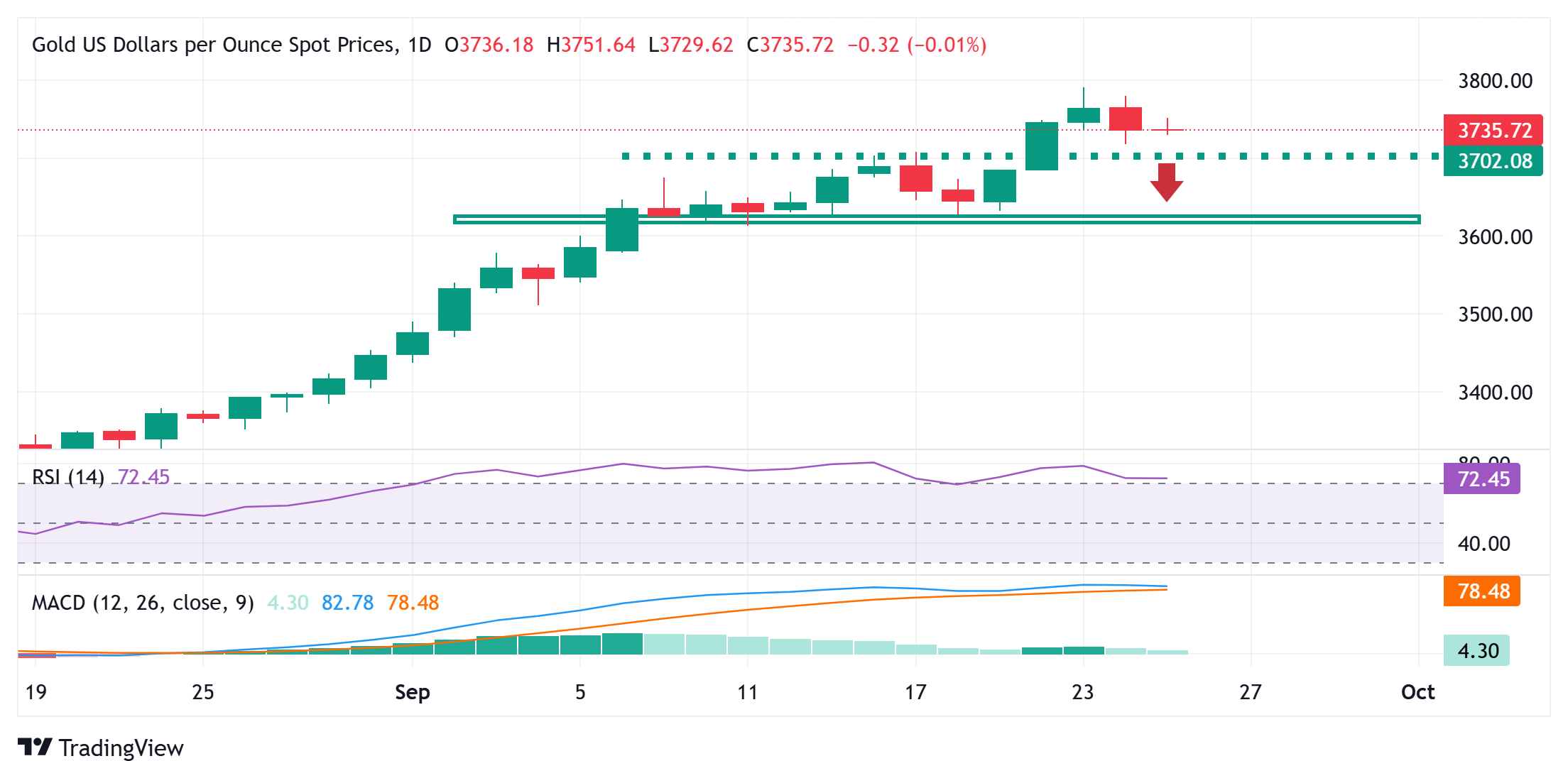Created
: 2025.09.25














![]() 2025.09.25 12:56
2025.09.25 12:56
Gold (XAU/USD) lacks any firm intraday directional bias on Thursday and seesaws between tepid gains/minor losses below the $3,750 level during the Asian session. The growing acceptance that the US Federal Reserve (Fed) will cut interest rates twice by the end of this year keeps a lid on the overnight US Dollar (USD) rally to a two-week high and acts as a tailwind for the non-yielding yellow metal. Moreover, persistent geopolitical risks stemming from the intensifying Russia-Ukraine war and conflicts in the Middle East further offer some support to the safe-haven commodity.
Meanwhile, Fed Chair Jerome Powell's cautious remarks on potential interest rate cuts earlier this week helped limit deeper USD losses and cap the upside for the Gold price. Traders also seem reluctant and opt to wait for important US macro data before positioning for the next leg of a directional move. Thursday's US economic docket features the release of the final Q2 GDP print, the usual Weekly Initial Jobless Claims, and Durable Goods Orders. The focus, however, will remain glued to the US Personal Consumption Expenditure (PCE) Price Index, or the Fed's preferred inflation gauge, on Friday.

From a technical perspective, this week's failure ahead of the $3,800 mark could be seen as the first sign of a possible bullish exhaustion amid still overbought Relative Strength Index (RSI) on the daily chart. That said, last week's breakout through the $3,700 mark was seen as a key trigger for the XAU/USD bulls and backs the case for the emergence of some dip-buying near the said handle. A convincing break below the latter, however, might prompt some technical selling and drag the Gold price to the $3,650 intermediate support en route to the $3,610-$3,600 region.
On the flip side, momentum beyond the Asian session high, around the $3,752 area, might confront some resistance near the $3,765-3,766 region. The subsequent move up would set the stage for a move towards retesting the all-time peak, around the $3,790 area. Some follow-through buying and acceptance above the $3,800 mark would set the stage for an extension of the recent well-established uptrend witnessed over the past month or so.
Gold has played a key role in human's history as it has been widely used as a store of value and medium of exchange. Currently, apart from its shine and usage for jewelry, the precious metal is widely seen as a safe-haven asset, meaning that it is considered a good investment during turbulent times. Gold is also widely seen as a hedge against inflation and against depreciating currencies as it doesn't rely on any specific issuer or government.
Central banks are the biggest Gold holders. In their aim to support their currencies in turbulent times, central banks tend to diversify their reserves and buy Gold to improve the perceived strength of the economy and the currency. High Gold reserves can be a source of trust for a country's solvency. Central banks added 1,136 tonnes of Gold worth around $70 billion to their reserves in 2022, according to data from the World Gold Council. This is the highest yearly purchase since records began. Central banks from emerging economies such as China, India and Turkey are quickly increasing their Gold reserves.
Gold has an inverse correlation with the US Dollar and US Treasuries, which are both major reserve and safe-haven assets. When the Dollar depreciates, Gold tends to rise, enabling investors and central banks to diversify their assets in turbulent times. Gold is also inversely correlated with risk assets. A rally in the stock market tends to weaken Gold price, while sell-offs in riskier markets tend to favor the precious metal.
The price can move due to a wide range of factors. Geopolitical instability or fears of a deep recession can quickly make Gold price escalate due to its safe-haven status. As a yield-less asset, Gold tends to rise with lower interest rates, while higher cost of money usually weighs down on the yellow metal. Still, most moves depend on how the US Dollar (USD) behaves as the asset is priced in dollars (XAU/USD). A strong Dollar tends to keep the price of Gold controlled, whereas a weaker Dollar is likely to push Gold prices up.
![]()
Created
: 2025.09.25
![]()
Last updated
: 2025.09.25

FXStreet is a forex information website, delivering market analysis and news articles 24/7.
It features a number of articles contributed by well-known analysts, in addition to the ones by its editorial team.
Founded in 2000 by Francesc Riverola, a Spanish economist, it has grown to become a world-renowned information website.
We hope you find this article useful. Any comments or suggestions will be greatly appreciated.
We are also looking for writers with extensive experience in forex and crypto to join us.
please contact us at [email protected].
Disclaimer:
All information and content provided on this website is provided for informational purposes only and is not intended to solicit any investment. Although all efforts are made in order to ensure that the information is correct, no guarantee is provided for the accuracy of any content on this website. Any decision made shall be the responsibility of the investor and Myforex does not take any responsibility whatsoever regarding the use of any information provided herein.
The content provided on this website belongs to Myforex and, where stated, the relevant licensors. All rights are reserved by Myforex and the relevant licensors, and no content of this website, whether in full or in part, shall be copied or displayed elsewhere without the explicit written permission of the relevant copyright holder. If you wish to use any part of the content provided on this website, please ensure that you contact Myforex.
Myforex uses cookies to improve the convenience and functionality of this website. This website may include cookies not only by us but also by third parties (advertisers, log analysts, etc.) for the purpose of tracking the activities of users. Cookie policy